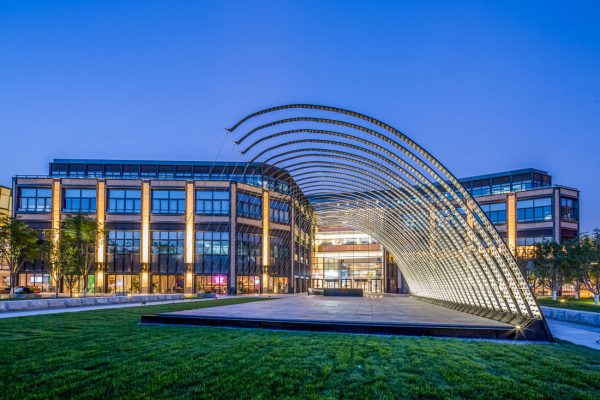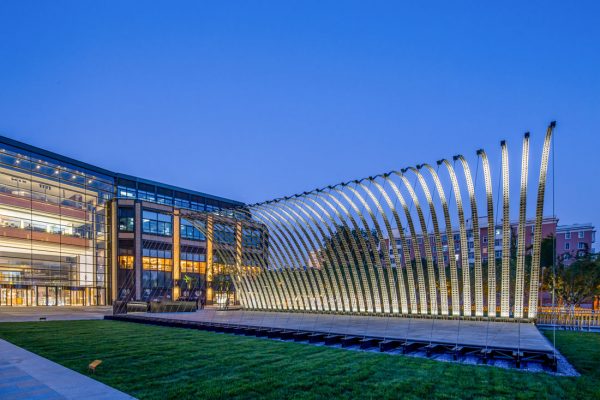The annual temporary arts pavilion makes its international debut in China’s capital. Designed by Liu Jiakun, the structure has a barely contained energy that’s the result of cutting-edge mechanics.

This year marks a new chapter in the Serpentine Pavilion’s journey: it’s the first year that the pavilion comes to Asia, and indeed, it’s the first year the pavilion appears anywhere outside of the UK. This year’s international pavilion opened on 29 May 2018, located on the green expanse in front of WF CENTRAL, Hongkong Land’s premium mixed-use development in Dongcheng District, Beijing.

The Serpentine Pavilion has been an annual fixture on the London summer arts scene, eagerly anticipated for the experiment approach each year’s commissioned international architecture firm will apply. Conceived by the Serpentine Galleries and launched in 2000, the pavilion has seen architects like Bjarke Ingels Group (BIG), Sou Fujimoto, Herzog & de Meuron, Rem Koolhaas and many others think outside the box to create temporary structures that invite people to engage with them and to take a different perspective.
For the first pavilion in China, the Serpentine Galleries sought the help of Liu Jiakun, Principal of JIAKUN Architects. Jiakun’s creation draws on the heritage of the Wangfujing area, as well as the 18-year history of the Serpentine Galleries.
“Working on the Serpentine Pavilion meant completing a project that requires a high-standard creativity in a limited time. Working on it in China, for me, means doing something that embodies both the Chinese spirit and a universal language,” says Jiakun.
To give the pavilion that ‘Chinese spirit’, Jiakun designed a dynamic form that resembles an archer poised to shoot an arrow from his bow. “The mechanical installation demonstrates a new structural concept: a series of layered spring steels, stacked thick at the bottom and thinner at the top, connected by bolts that play the role of ‘bow’.

Explains Liu, “Cables that work as ‘string’ pull the bow back, with the support of steel beams at the bottom as the ‘arrow’, to maintain balance. The elasticity and tension from the materials form an unsupported, self-stabilising structure that is full of inner energy.”
Powerful movement and balance: these elements counter each other in Jiakun’s thoughtful and precise design, making Beijing’s first Serpentine Pavilion a physical embodiment of junzi, a Confucian concept pursued by the “superior man,” says Jiakun.

The architect also drew on the form and materials of the nearby Forbidden City, paying tribute to China’s heritage. He used “jin zhuan, a special floor tile used for the Forbidden City in ancient China and fired in the southern region of the Yangtze River,” he says, and he referenced the arched forms of the Forbidden City’s roofs. “In line with the architectural design of the Forbidden City, we used anti-warping methods, echoing the cornices of China’s traditional roofs.”
The resulting structure is dynamic and beautiful in its apparent simplicity – and yet Jiakun says the sense of movement was harder to achieve than it looks. He explains, “The new structural mechanics, the ‘bow-arch structure’… seems simple, but actually, it required calculations and testing at every step of the way.”
A searchable and comprehensive guide for specifying leading products and their suppliers
Keep up to date with the latest and greatest from our industry BFF's!

Elevate any space with statement lighting to illuminate and inspire.

In this candid interview, the culinary mastermind behind Singapore’s Nouri and Appetite talks about food as an act of human connection that transcends borders and accolades, the crucial role of technology in preserving its unifying power, and finding a kindred spirit in Gaggenau’s reverence for tradition and relentless pursuit of innovation.

To honour Chef James Won’s appointment as Gaggenau’s first Malaysian Culinary Partner, we asked the gastronomic luminaire about parallels between Gaggenau’s ethos and his own practice, his multidimensional vision of Modern Malaysian – and how his early experiences of KFC’s accessible, bold flavours influenced his concept of fine dining.

Spectacular architectural pavilions are big crowd-pleasers, but critics claim they’re running out of control.

61 tonnes of slate define the 2019 Serpentine Pavilion in London. Junya Ishigami describes it as “a hill made out of rocks”.
The internet never sleeps! Here's the stuff you might have missed

A packed audience at Living Edge was treated to an insightful panel discussion on ‘The Queer Wish List’ as part of Queers in Property NSW.

With the launch of its renewed studio in Melbourne, Grimshaw displays expertise in creating a sophisticated and elegant space that is just the place for staff and clients to work and meet.

Renowned architect Madeleine Blanchfield shares insights into her design philosophy, her journey into architecture, and the award-winning project, Vessel. As the founder of Madeleine Blanchfield Architects, she discusses the challenges and triumphs of working with heritage buildings and creating homes that adapt to their owners’ evolving needs.